Seepage-Induced Pore Pressure Variations Beneath an Earthen Levee Measured with a Novel Seismic Tool
Abstract
1. Introduction
2. Geological and Geotechnical Setting of the Study Area
3. Methods
3.1. Seismic Field Methods and Data Processing
3.2. Predictions of Effective Pressure from S-Wave Velocity
3.3. Differential Pore Pressure
3.4. Fluid Flow Pressure Model and Stress Distribution Diagram to Predict Effective Pressure
3.5. Comparison of Seismic Data and Stress Model
4. Results
5. Discussion
6. Conclusions
Author Contributions
Funding
Data Availability Statement
Acknowledgments
Conflicts of Interest
References
- Boyd, E. Assessing the Benefits of Levees: An Economic Assessment of US Counties with Levees; Levees.org: New Orleans, LA, USA, 2009. [Google Scholar]
- Zimmer, M.A. Seismic Velocities in Unconsolidated Sands: Measurements of Pressure, Sorting, and Compaction Effects; Stanford University: Stanford, CA, USA, 2004. [Google Scholar]
- Schiermeier, Q. Increased flood risk linked to global warming. Nature 2011, 470, 316. [Google Scholar] [CrossRef] [PubMed]
- Ward, P.J.; Winsemius, H.C.; Kuzma, S.; Bierkens, M.F.; Bouwman, A.; De Moel, H.; Loaiza, A.D.; Eilander, D.; Englhardt, J.; Erkens, G. Aqueduct floods methodology. World Resour. Inst. 2020, 1–28. Available online: https://www.wri.org/research/aqueduct-floods-methodology (accessed on 12 December 2022).
- Cola, S.; Girardi, V.; Bersan, S.; Simonini, P.; Schenato, L.; De Polo, F. An optical fiber-based monitoring system to study the seepage flow below the landside toe of a river levee. J. Civ. Struct. Health Monit. 2021, 11, 691–705. [Google Scholar] [CrossRef]
- Cooper, H.H.; Rorabaugh, M.I. Ground-water movements and bank storage due to flood stages in surface streams. U.S.G.P.O. 1963, ill, 343–366. [Google Scholar]
- Heinrich, P.; Autin, W. Baton Rouge 30 X 60 Minute Geologic Quadrangle: Louisiana Geological Survey; Louisiana Geological Survey: Baton Rouge, LA, USA, 2000. [Google Scholar]
- Ozkan, S.; Adrian, D.D.; Sills, G.L.; Singh, V.P. Transient Head Development due to Flood Induced Seepage under Levees. J. Geotech. Geoenvironmental Eng. 2008, 134, 781–789. [Google Scholar] [CrossRef]
- USACE. The Mississippi River & Tributaries Project: History of the Lower Mississippi River Levee System; Mississippi River Commission: Vicksburg, MS, USA, 2007. [Google Scholar]
- Fisk, H.N. Geological Investigation of the Alluvial Valley of the Lower Mississippi River, 170; Mississippi River Commission: Vicksburg, MS, USA, 1944. [Google Scholar]
- Meyer, R.R.; Turcan, A.N. Geology and Ground-water Resources of the Baton Rouge Area, Louisiana; US Government Printing Office: Washington, DC, USA, 1955. [Google Scholar]
- Turnbull, W.; Mansur, C. Underseepage and its control: A symposium: Investigation of underseepage-Mississippi River levees. Trans. Am. Soc. Civ. Eng. 1961, 126, 1429–1481. [Google Scholar] [CrossRef]
- Dunnicliff, J. Geotechnical Instrumentation for Monitoring Field Performance; John Wiley & Sons: Hoboken, NJ, USA, 1993. [Google Scholar]
- Van Der Kamp, G. Methods for determining the in situ hydraulic conductivity of shallow aquitards—An overview. Hydrogeol. J. 2001, 9, 5–16. [Google Scholar] [CrossRef]
- Mansur, C.I.; Postol, G.; Salley, J.R. Performance of Relief Well Systems along Mississippi River Levees. J. Geotech. Geoenviron. Eng. 2000, 126, 727–738. [Google Scholar] [CrossRef]
- Zhu, L.; Gong, H.; Chen, Y.; Li, X.; Chang, X.; Cui, Y. Improved estimation of hydraulic conductivity by combining stochastically simulated hydrofacies with geophysical data. Sci. Rep. 2016, 6, 22224. [Google Scholar] [CrossRef]
- Lorenzo, J.; Doll, W. Levees and Dams: Advances in Geophysical Monitoring and Characterization; Springer: Cham, Switzerland; Berlin/Heidelberg, Germany, 2019. [Google Scholar] [CrossRef]
- Ivanov, J.; Miller, R.D.; Ballard, R.F., Jr.; Dunbar, J.B.; Smullen, S. Time-lapse seismic study of levees in southern Texas. In SEG Technical Program Expanded Abstracts 2005; Society of Exploration Geophysicists: Houston, TX, USA, 2005; pp. 1121–1124. [Google Scholar]
- Ivanov, J.; Miller, R.D.; Stimac, N.; Ballard, R.F., Jr.; Dunbar, J.B.; Smullen, S. Time-lapse seismic study of levees in southern New Mexico. In SEG Technical Program Expanded Abstracts 2006; Society of Exploration Geophysicists: New Orleans, LA, USA, 2006; pp. 3255–3259. [Google Scholar]
- Lu, N.; Likos, W.J. Unsaturated Soil Mechanics; J. Wiley Hoboken: Hoboken, NJ, USA, 2004. [Google Scholar]
- Pasquet, S.; Bodet, L.; Bergamo, P.; Guérin, R.; Martin, R.; Mourgues, R.; Tournat, V. Small-scale seismic monitoring of varying water levels in granular media. Vadose Zone J. 2016, 15, 1–14. [Google Scholar] [CrossRef]
- Cameron, A.; Knapp, C. A new approach to predict hydrogeological parameters using shear waves from multichannel analysis of surface waves method. In Proceedings of the Symposium on the Application of Geophysics to Engineering and Environmental Problems, Denver, CO, USA, 20–24 March 2009; p. 475. [Google Scholar]
- Grelle, G.; Guadagno, F.M. Seismic refraction methodology for groundwater level determination: “Water seismic index”. J. Appl. Geophys. 2009, 68, 301–320. [Google Scholar] [CrossRef]
- Konstantaki, L.; Carpentier, S.; Garofalo, F.; Bergamo, P.; Socco, L. Determining hydrological and soil mechanical parameters from multichannel surface-wave analysis across the Alpine Fault at Inchbonnie, New Zealand. Near Surf. Geophys. 2013, 11, 435–448. [Google Scholar] [CrossRef]
- Pasquet, S.; Holbrook, W.; Carr, B.; Sims, K. Geophysical imaging of shallow degassing in a Yellowstone hydrothermal system. Geophys. Res. Lett. 2016, 43, 12027–12035. [Google Scholar] [CrossRef]
- Pride, S.R. Relationships between seismic and hydrological properties. In Hydrogeophysics; Springer: Berlin/Heidelberg, Germany, 2005; pp. 253–290. [Google Scholar]
- Bergamo, P.; Dashwood, B.; Uhlemann, S.; Swift, R.; Chambers, J.E.; Gunn, D.A.; Donohue, S. Time-lapse monitoring of fluid-induced geophysical property variations within an unstable earthwork using P-wave refraction. Geophysics 2016, 81, EN17–EN27. [Google Scholar] [CrossRef]
- Bergamo, P.; Socco, L.V. P-and S-wave velocity models of shallow dry sand formations from surface wave multimodal inversionVP and VS model of dry sand with SW. Geophysics 2016, 81, R197–R209. [Google Scholar] [CrossRef]
- Ikeda, T.; Tsuji, T.; Takanashi, M.; Kurosawa, I.; Nakatsukasa, M.; Kato, A.; Worth, K.; White, D.; Roberts, B. Temporal variation of the shallow subsurface at the Aquistore CO2 storage site associated with environmental influences using a continuous and controlled seismic source. J. Geophys. Res. Solid Earth 2017, 122, 2859–2872. [Google Scholar] [CrossRef]
- Lu, Z. Feasibility of using a seismic surface wave method to study seasonal and weather effects on shallow surface soils. J. Environ. Eng. Geophys. 2014, 19, 71–85. [Google Scholar] [CrossRef]
- Ajo-Franklin, J.; Dou, S.; Daley, T.; Freifeld, B.; Robertson, M.; Ulrich, C.; Wood, T.; Eckblaw, I.; Lindsey, N.; Martin, E. Time-lapse surface wave monitoring of permafrost thaw using distributed acoustic sensing and a permanent automated seismic source. In Proceedings of the 2017 SEG International Exposition and Annual Meeting, Houston, TX, USA, 27 September 2017. [Google Scholar]
- Arts, R.; Eiken, O.; Chadwick, A.; Zweigel, P.; Van der Meer, L.; Zinszner, B. Monitoring of CO2 injected at Sleipner using time lapse seismic data. In Proceedings of the Greenhouse Gas Control Technologies-6th International Conference, Kyoto, Japan, 1–4 October 2002; pp. 347–352. [Google Scholar]
- Chadwick, A.; Williams, G.; Delepine, N.; Clochard, V.; Labat, K.; Sturton, S.; Buddensiek, M.-L.; Dillen, M.; Nickel, M.; Lima, A.L.; et al. Quantitative analysis of time-lapse seismic monitoring data at the Sleipner CO2 storage operation. Lead. Edge 2010, 29, 170–177. [Google Scholar] [CrossRef]
- St. Clair, J.; Moon, S.; Holbrook, W.; Perron, J.; Riebe, C.; Martel, S.; Carr, B.; Harman, C.; Singha, K.; deB. Richter, D. Geophysical imaging reveals topographic stress control of bedrock weathering. Science 2015, 350, 534–538. [Google Scholar] [CrossRef]
- Landrø, M. Discrimination between pressure and fluid saturation changes from time-lapse seismic data. Geophysics 2001, 66, 836–844. [Google Scholar] [CrossRef]
- Lumley, D.E. Time-lapse seismic reservoir monitoring. Geophysics 2001, 66, 50–53. [Google Scholar] [CrossRef]
- Johnston, D.H. Practical Applications of Time-Lapse Seismic Data; Society of Exploration Geophysicists: Houston, TX, USA, 2013. [Google Scholar] [CrossRef]
- Domenico, S. Effect of brine-gas mixture on velocity in an unconsolidated sand reservoir. Log Anal. 1977, 18. [Google Scholar] [CrossRef]
- Estes, C.; Mavko, G.; Yin, H.; Cadoret, T. Measurements of velocity, porosity, and permeability on unconsolidated granular materials. SRB Annu. Rep. B 1994, 55, G1-1–G1-9. [Google Scholar]
- Prasad, M.; Meissner, R. Attenuation mechanisms in sands: Laboratory versus theoretical (Biot) data. Geophysics 1992, 57, 710–719. [Google Scholar] [CrossRef]
- Robertson, P.; Sasitharan, S.; Cunning, J.; Sego, D. Shear-wave velocity to evaluate in-situ state of Ottawa sand. J. Geotech. Eng. 1995, 121, 262–273. [Google Scholar] [CrossRef]
- Yin, H. Acoustic Velocity and Attenuation of Rocks: Isotropy, Intrinsic Anisotropy, and Stress-induced Anisotropy; Stanford University: Stanford, CA, USA, 1993. [Google Scholar]
- Hofmann, R.; Xu, X.; Batzle, M.; Prasad, M.; Furre, A.-K.; Pillitteri, A. Effective pressure or what is the effect of pressure? Lead. Edge 2005, 24, 1256–1260. [Google Scholar] [CrossRef]
- Terzaghi, K. Theoretical Soil Mechanics; John Wiley & Sons: Hoboken, NJ, USA, 1943. [Google Scholar]
- Huffman, A.R.; Castagna, J.P. The petrophysical basis for shallow-water flow prediction using multicomponent seismic data. Lead. Edge 2001, 20, 1030–1052. [Google Scholar] [CrossRef]
- Zimmer, M.A.; Prasad, M.; Mavko, G.; Nur, A. Seismic velocities of unconsolidated sands: Part 1—Pressure trends from 0.1 to 20 MPa. Geophysics 2007, 72, E1–E13. [Google Scholar] [CrossRef]
- Castagna, J.P. Petrophysical imaging using AVO. Lead. Edge 1993, 12, 172–178. [Google Scholar] [CrossRef]
- Eberhart-Phillips, D.; Han, D.-H.; Zoback, M. Empirical relationships among seismic velocity, effective pressure, porosity, and clay content in sandstone. Geophysics 1989, 54, 82–89. [Google Scholar] [CrossRef]
- Lee, M.W. Predicting S-Wave Velocities for Unconsolidated Sediments at Low Effective Pressure; U. S. Geological Survey: Denver, CO, USA, 2010. [Google Scholar]
- Prasad, M. Acoustic measurements in unconsolidated sands at low effective pressure and overpressure detection. Geophysics 2002, 67, 405–412. [Google Scholar] [CrossRef]
- Shen, J.; Crane, J.M.; Lorenzo, J.M.; White, C.D. Seismic velocity prediction in shallow (<30 m) partially saturated, unconsolidated sediments using effective medium theory. J. Environ. Eng. Geophys. 2016, 21, 67–78. [Google Scholar]
- Velea, D.; Shields, F.D.; Sabatier, J.M. Elastic wave velocities in partially saturated Ottawa sand: Experimental results and modeling. Soil Sci. Soc. Am. J. 2000, 64, 1226–1234. [Google Scholar] [CrossRef]
- Walton, K. The effective elastic moduli of a random packing of spheres. J. Mech. Phys. Solids 1987, 35, 213–226. [Google Scholar] [CrossRef]
- Lee, M.W. A simple method of predicting S-wave velocity. Geophysics 2006, 71, F161–F164. [Google Scholar] [CrossRef]
- USACE. Design and Construction of Levees: In Engineering and Design Manuals; Dept. of the Army: Washington, DC, USA, 2000. [Google Scholar]
- Kolb, C.; Van Lopik, J. Geology of the Mississippi River Deltaic Plain, Southeastern Louisiana: US Army Corps of Engineers; Technical Report 2; Waterways Experiment Station: Vicksburg, MS, USA, 1958. [Google Scholar]
- Jafari, N.H.; Cadigan, J.A.; Stark, T.D.; Woodward, M.L. Phreatic Surface Migration through an Unsaturated Levee Embankment. J. Geotech. Geoenvironmental Eng. 2019, 145, 11. [Google Scholar] [CrossRef]
- Woodward, M. Mississippi River Levees LSU-Duncan Point Seepage Study; Rep. No. ITEM M-227.5 to 217.1-L; U.S. Army Corps of Engineers: Washington, DC, USA, 1992. [Google Scholar]
- DeHaan, H.; Stamper, J.; Walters, B. Mississippi River and Tributaries System 2011 Post-Flood Report: Documenting the 2011 Flood, the Corps’ Response, and the Performance of the MR&T System; U.S. Army Corps of Engineers Digital Library: Vicksburg, MS, USA, 2012. [Google Scholar]
- Fisk, H.N. Geological Investigation of the Atchafalaya Basin and the Problem of Mississippi River Diversion; Waterways Experiment Station: Vicksburg, MS, USA, 1952. [Google Scholar]
- Saucier, R.T. Geomorphology and Quaternary Geologic History of the Lower Mississippi Valley; US Army Engineer Waterways Experiment Station: Vicksburg, MS, USA, 1994; Volume 1. [Google Scholar]
- Thomas, R.G.; Smith, D.G.; Wood, J.M.; Visser, J.; Calverley-Range, E.A.; Koster, E.H. Inclined heterolithic stratification—Terminology, description, interpretation and significance. Sediment. Geol. 1987, 53, 123–179. [Google Scholar] [CrossRef]
- Saucier, R.T. Geological Investigation of the Mississippi River Area, Artonish to Donaldsville, La; Waterways Experiment Station: Vicksburg, MS, USA, 1969. [Google Scholar]
- Gibling, M.; Rust, B. Alluvial ridge-and-swale topography: A case study from the Morien Group of Atlantic Canada. Alluv. Sediment. 1993, 17, 133–150. [Google Scholar]
- Allen, J. The classification of cross-stratified units. With notes on their origin. Sedimentology 1963, 2, 93–114. [Google Scholar] [CrossRef]
- McGowen, J.; Garner, L. Physiographic Features and Stratification Types of Coarse-Grained Pointbars: Modern and Ancient Examples 1. Sedimentology 1970, 14, 77–111. [Google Scholar] [CrossRef]
- Davies, D.K. Sedimentary structures and subfacies of a Mississippi River point bar. J. Geol. 1966, 74, 234–239. [Google Scholar] [CrossRef]
- Evans, B.J. A Handbook for Seismic Data Acquisition in Exploration; Society of Exploration Geophysicists: Houston, TX, USA, 1997. [Google Scholar] [CrossRef]
- Vincent, P.D.; Steeples, D.W.; Tsoflias, G.P.; Sloan, S.D. Two approaches to noise tests. In SEG Technical Program Expanded Abstracts 2005; Society of Exploration Geophysicists: Houston, TX, USA, 2005; pp. 1180–1183. [Google Scholar]
- Lorenzo, J.M.; Hicks, J.; Vera, E.E. Integrated seismic and cone penetration test observations at a distressed earthen levee: Marrero, Louisiana, U.S.A. Eng. Geol. 2014, 168, 59–68. [Google Scholar] [CrossRef]
- Stockwell, J.W., Jr. The CWP/SU: Seismic Un∗ x package. Comput. Geosci. 1999, 25, 415–419. [Google Scholar] [CrossRef]
- Taner, M.T.; Koehler, F. Velocity spectra—Digital computer derivation applications of velocity functions. Geophysics 1969, 34, 859–881. [Google Scholar] [CrossRef]
- Stolt, R.H. Migration by Fourier transform. Geophysics 1978, 43, 23–48. [Google Scholar] [CrossRef]
- Helbig, K. Shear-waves—What they are and how they can be used. Shear-Wave Explor. Ed. SN Domen. SH Danbom Geophys. Dev. Ser. 1986, 1, 19–36. [Google Scholar]
- Stümpel, H.; Kähler, S.; Meissner, R.; Milkereit, B. The use of seismic shear waves and compressional waves for lithological problems of shallow sediments. Geophys. Prospect. 1984, 32, 662–675. [Google Scholar] [CrossRef]
- Liner, C.L. Elements of 3D Seismology; Society of Exploration Geophysicists: Tulsa, OK, USA, 2016. [Google Scholar]
- Sheriff, R.E. Geophysical Methods; Prentice Hall: Hoboken, NJ, USA, 1989. [Google Scholar]
- Jarvis, K.D.; Knight, R.J. Aquifer heterogeneity from SH-wave seismic impedance inversion. Geophysics 2002, 67, 1548–1557. [Google Scholar] [CrossRef]
- Harris, J.B. Hammer-impact SH-wave seismic reflection methods in neotectonic investigations: General observations and case histories from the Mississippi Embayment, USA. J. Earth Sci. 2009, 20, 513–525. [Google Scholar] [CrossRef]
- Lorenzo, J.M.; Rousset, D.; Senechal, G. L_SU (V0. 3.9): A graphical user interface useful for building seismic flows from Seismic Unix. In Proceedings of the AGU Fall Meeting Abstracts, San Francisco, CA, USA, 9–13 December 2019; p. NS21A-10. [Google Scholar]
- Miller, R.D.; Xia, J.; Park, C.B. Love waves: A menace to shallow shear wave reflection surveying. In SEG Technical Program Expanded Abstracts 2001; Society of Exploration Geophysicists: San Antonio, LA, USA, 2001; pp. 1377–1380. [Google Scholar]
- Hammah, R.; Curran, J. Geostatistics in geotechnical engineering: Fad or empowering? GeoCongress 2006, 2006, 1–5. [Google Scholar]
- Fam, M.; Santhamarian, J. A study of consolidation using mechanical and electromagnetic waves. Geotechnique 1997, 47, 203–219. [Google Scholar] [CrossRef]
- Peter, P. Canal and River Levees. Dev. Geotech. Eng. 1982, 29, 249–253. [Google Scholar]
- Ferris, J.G. Cyclic Fluctuations of Water Level as a Basis for Determining Aquifer Transmissibility; US Geological Survey: Washington, DC, USA, 1952. [Google Scholar]
- Pinder, G.F.; Bredehoeft, J.D.; Cooper, H.H., Jr. Determination of aquifer diffusivity from aquifer response to fluctuations in river stage. Water Resour. Res. 1969, 5, 850–855. [Google Scholar] [CrossRef]
- Hall, F.R.; Moench, A.F. Application of the convolution equation to stream-aquifer relationships. Water Resour. Res. 1972, 8, 487–493. [Google Scholar] [CrossRef]
- Ozkan, S.; Adrian, D.D. Analytical Construction of Transient Flow Nets in Homogeneous and Isotropic Flow Medium. J. Geotech. Geoenvironmental Eng. 2008, 134, 888–893. [Google Scholar] [CrossRef]
- Heinrich, P.; Paulsell, R.; Milner, R.; Snead, J.; Peele, H. Investigation and GIS Development of the Buried Holocene-Pleistocene Surface in the Louisiana Coastal Plain; Louisiana State University, Louisiana Geological Survey: Baton Rouge, LA, USA, 2015. [Google Scholar]
- Park, C.B. MASW horizontal resolution in 2D shear-velocity (Vs) mapping. Open-File Rep. Lawrence Kans. Geol. Surv. 2005, 36, 1–11. [Google Scholar]
- Ivanov, J.; Miller, R.D.; Feigenbaum, D.; Morton, S.L.; Peterie, S.L.; Dunbar, J.B. Revisiting levees in southern Texas using Love-wave multichannel analysis of surface waves with the high-resolution linear Radon transform. Interpretation 2017, 5, T287–T298. [Google Scholar] [CrossRef]
- Lu, N.; Likos, W. Suction stress characteristic curve for unsaturated soil. J. Geotech. Geoenviron. Eng. 2006, 132, 131–142. [Google Scholar] [CrossRef]
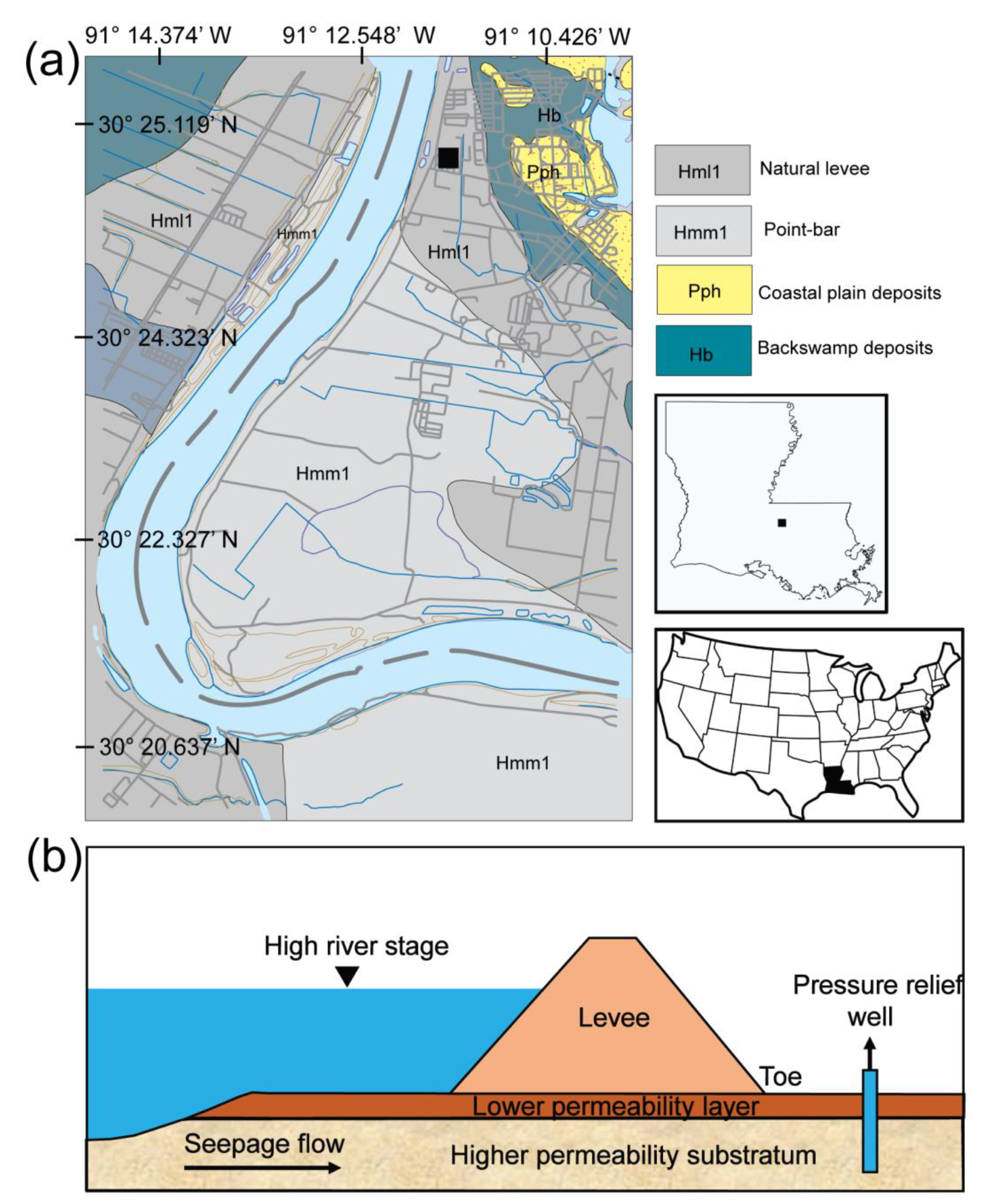
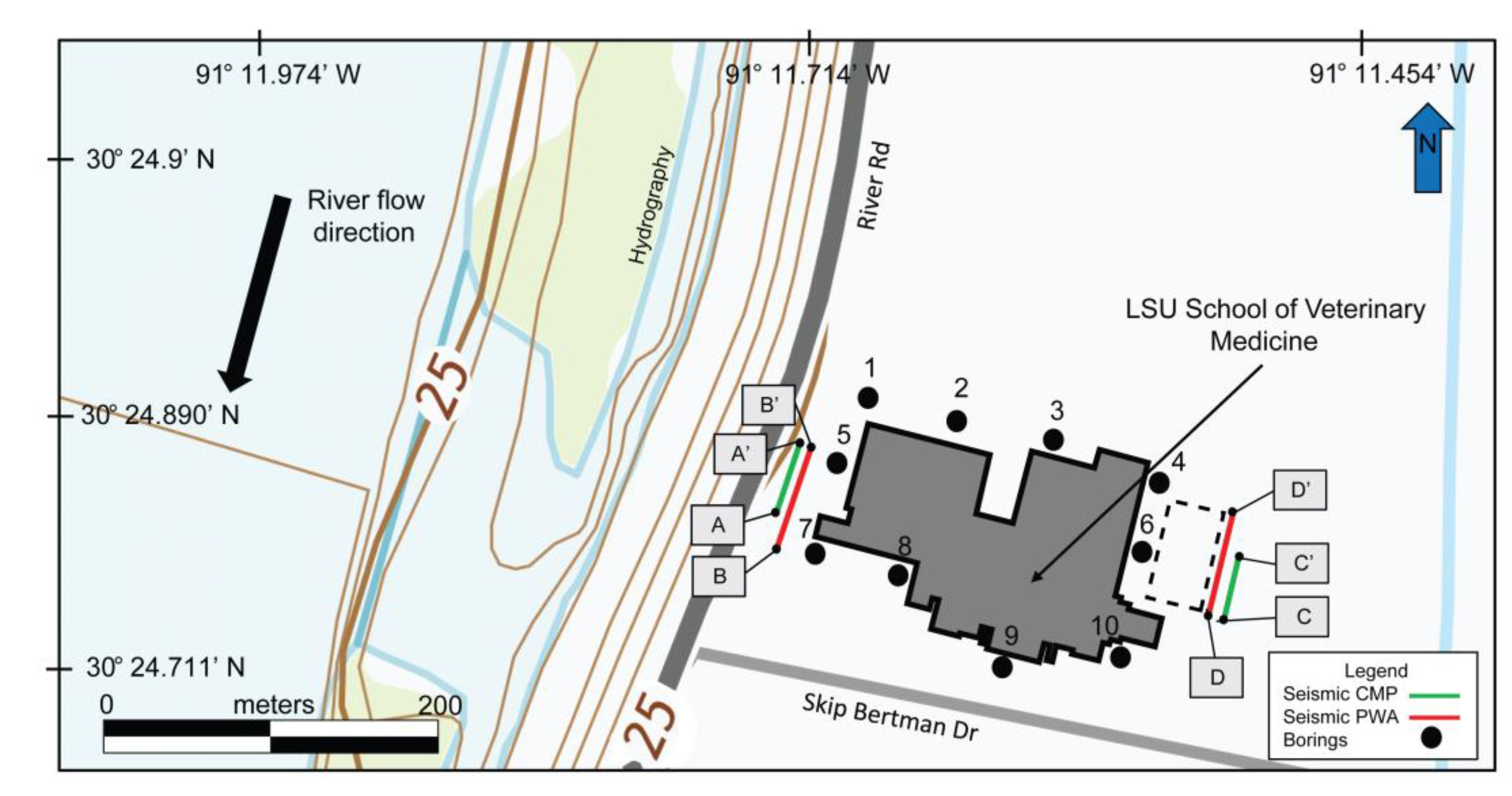

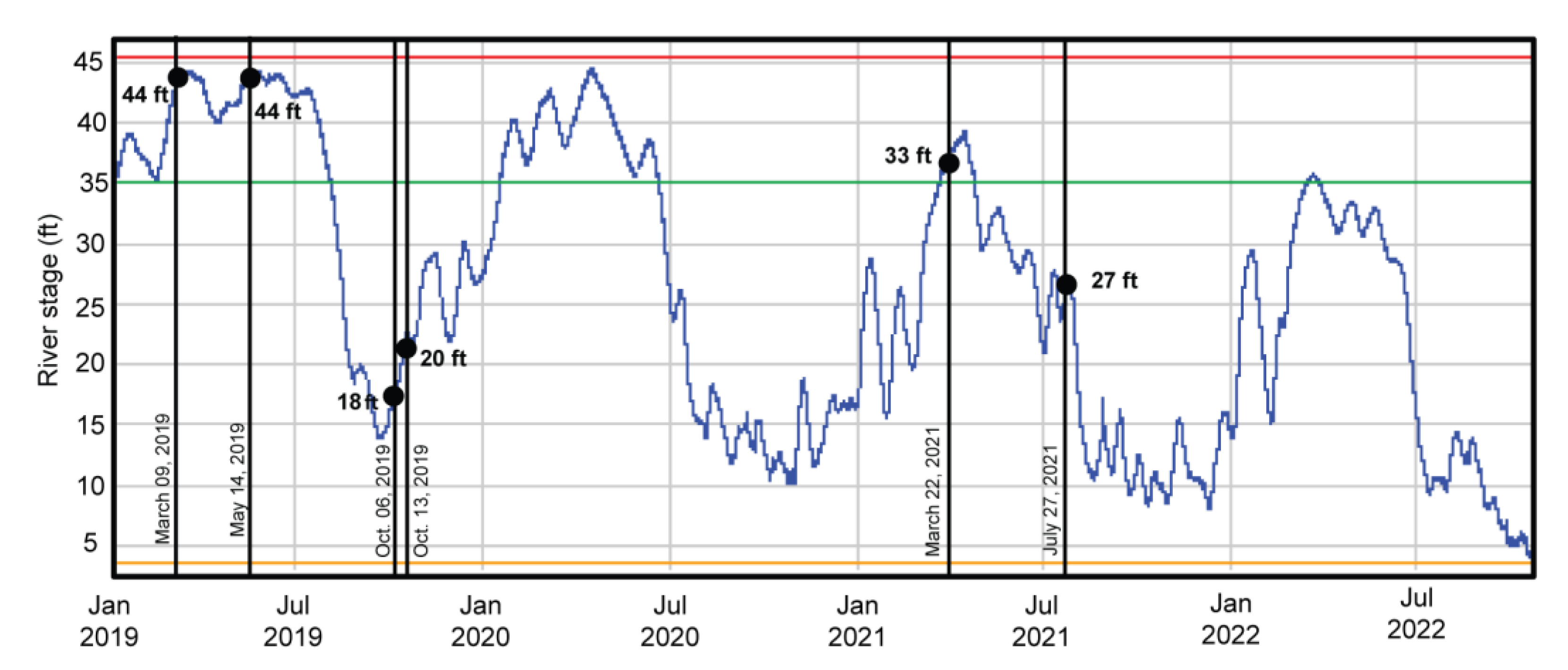

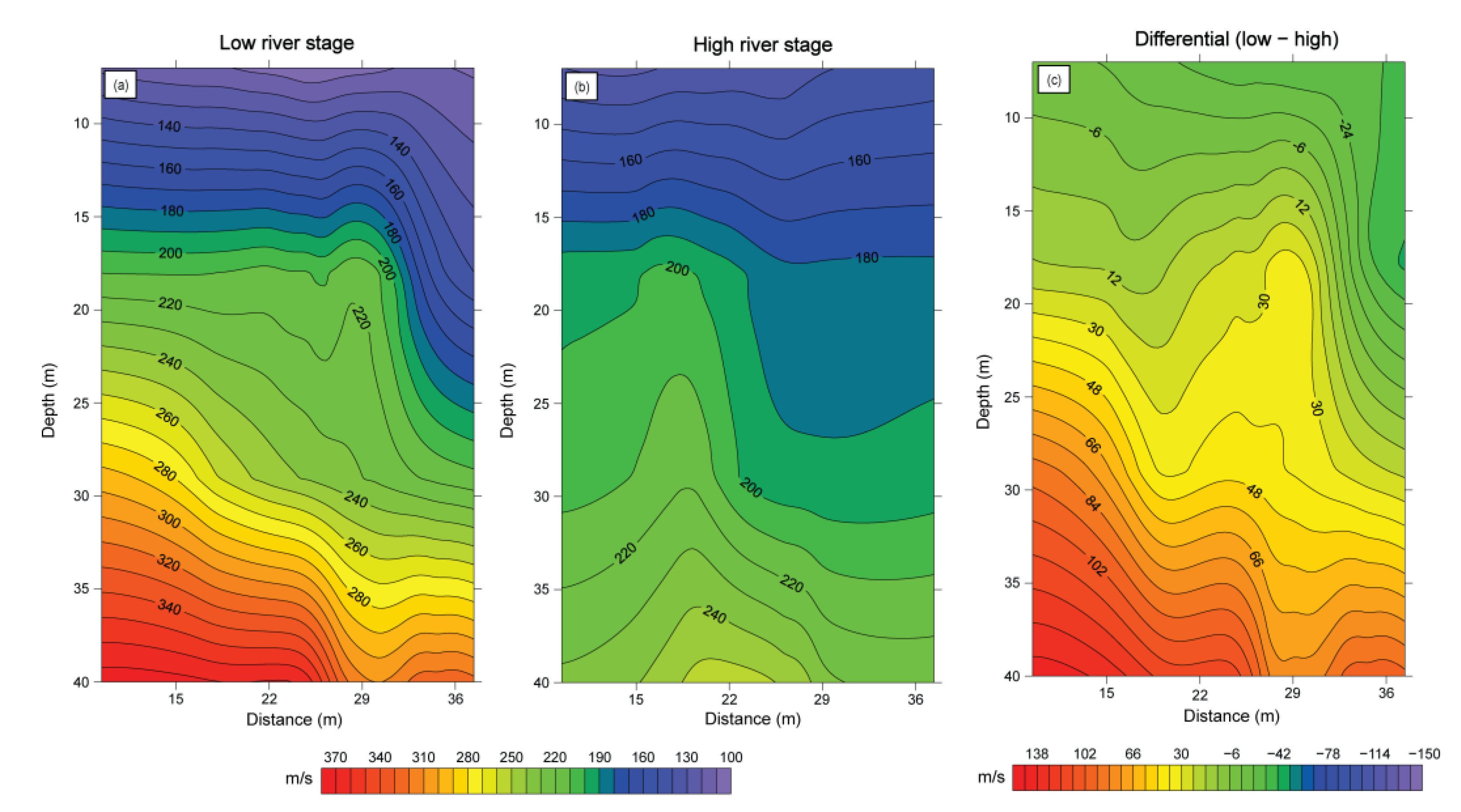



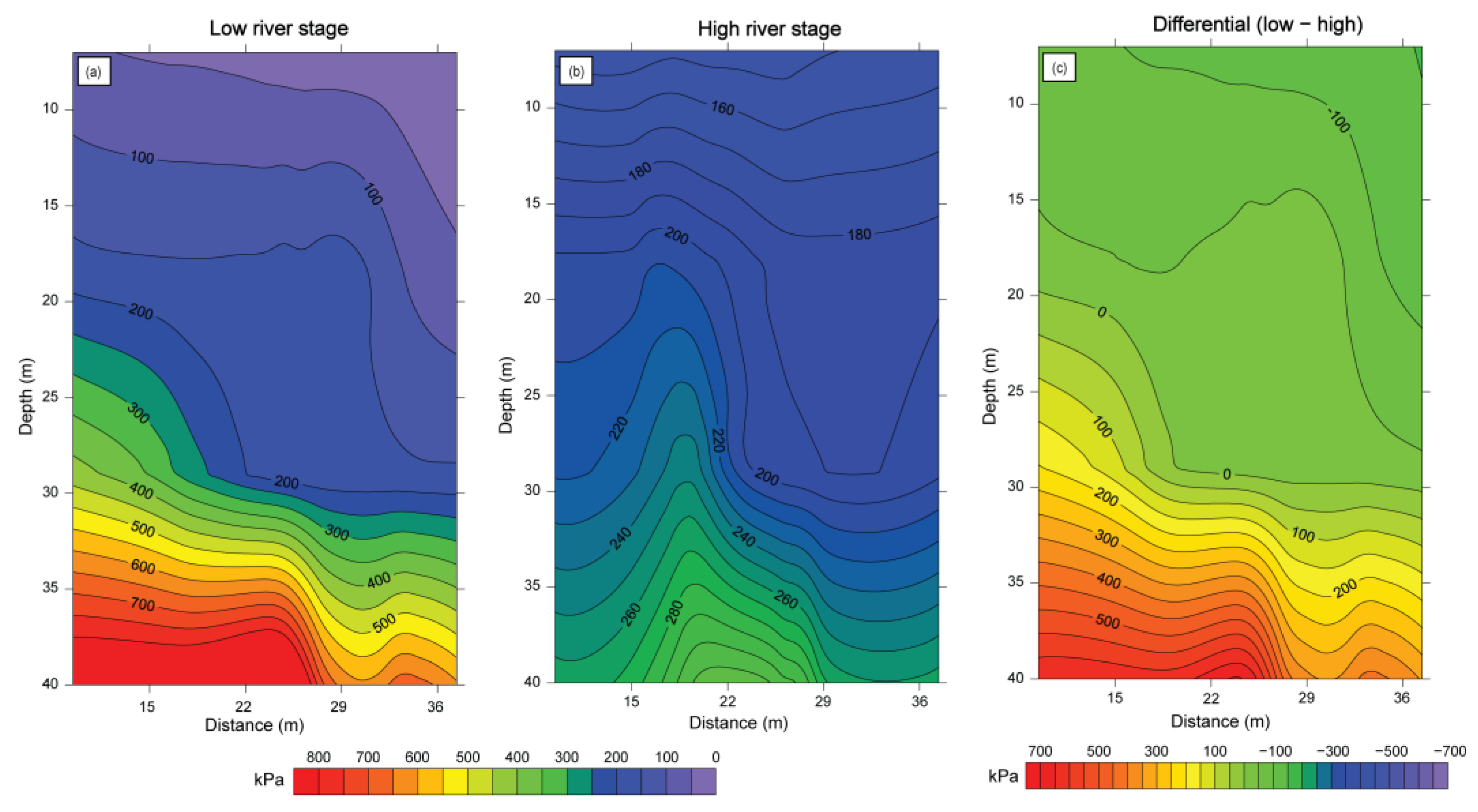
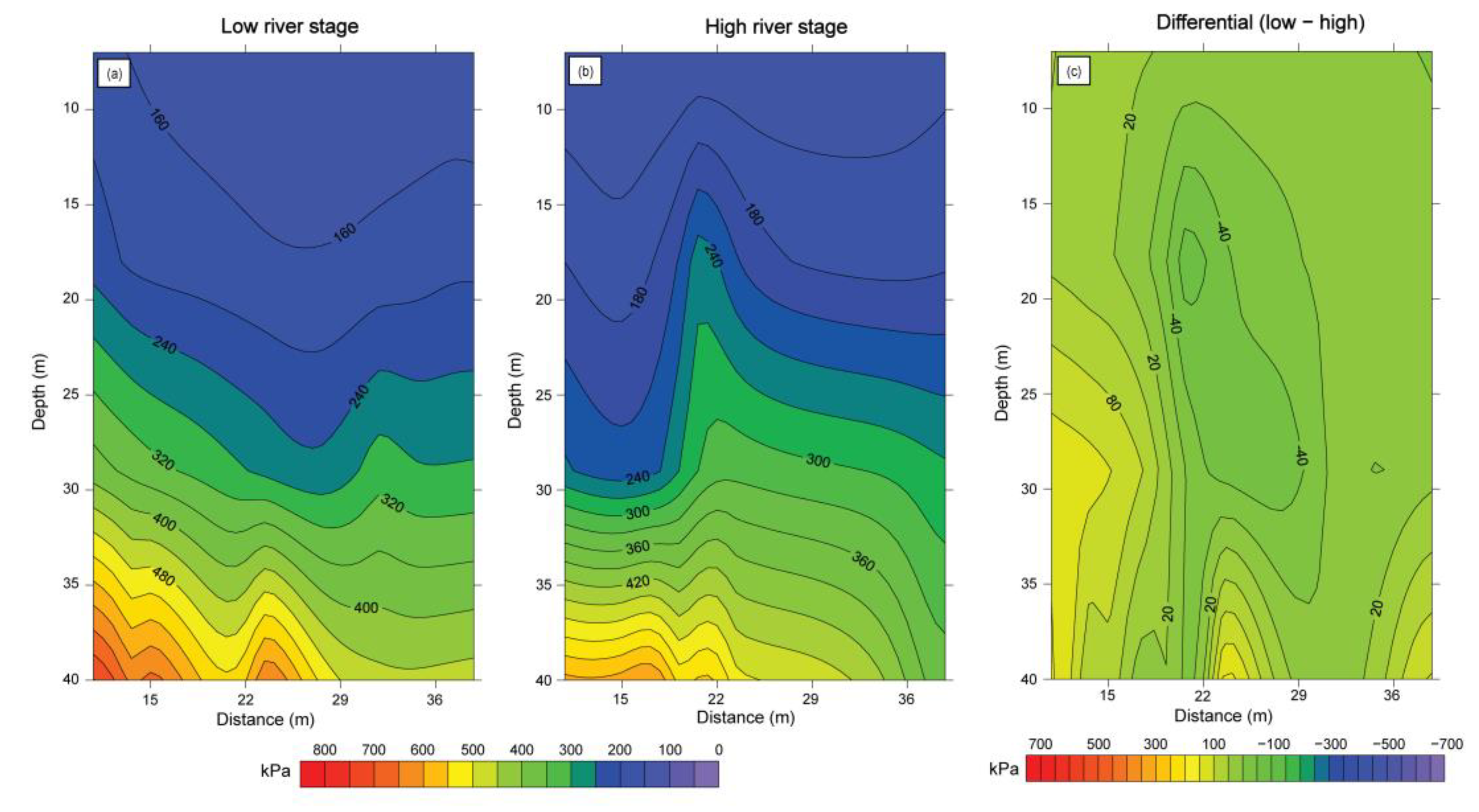
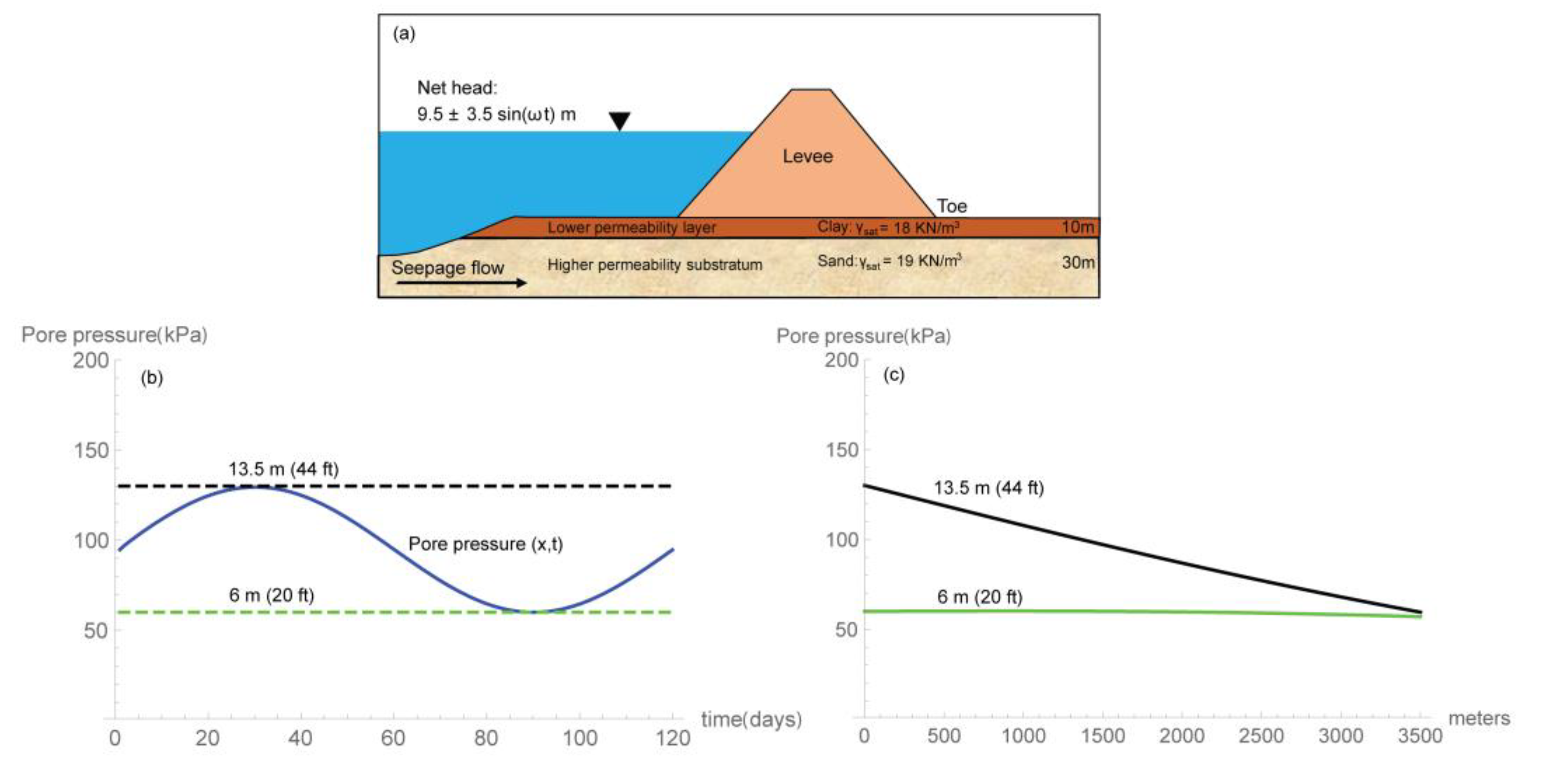
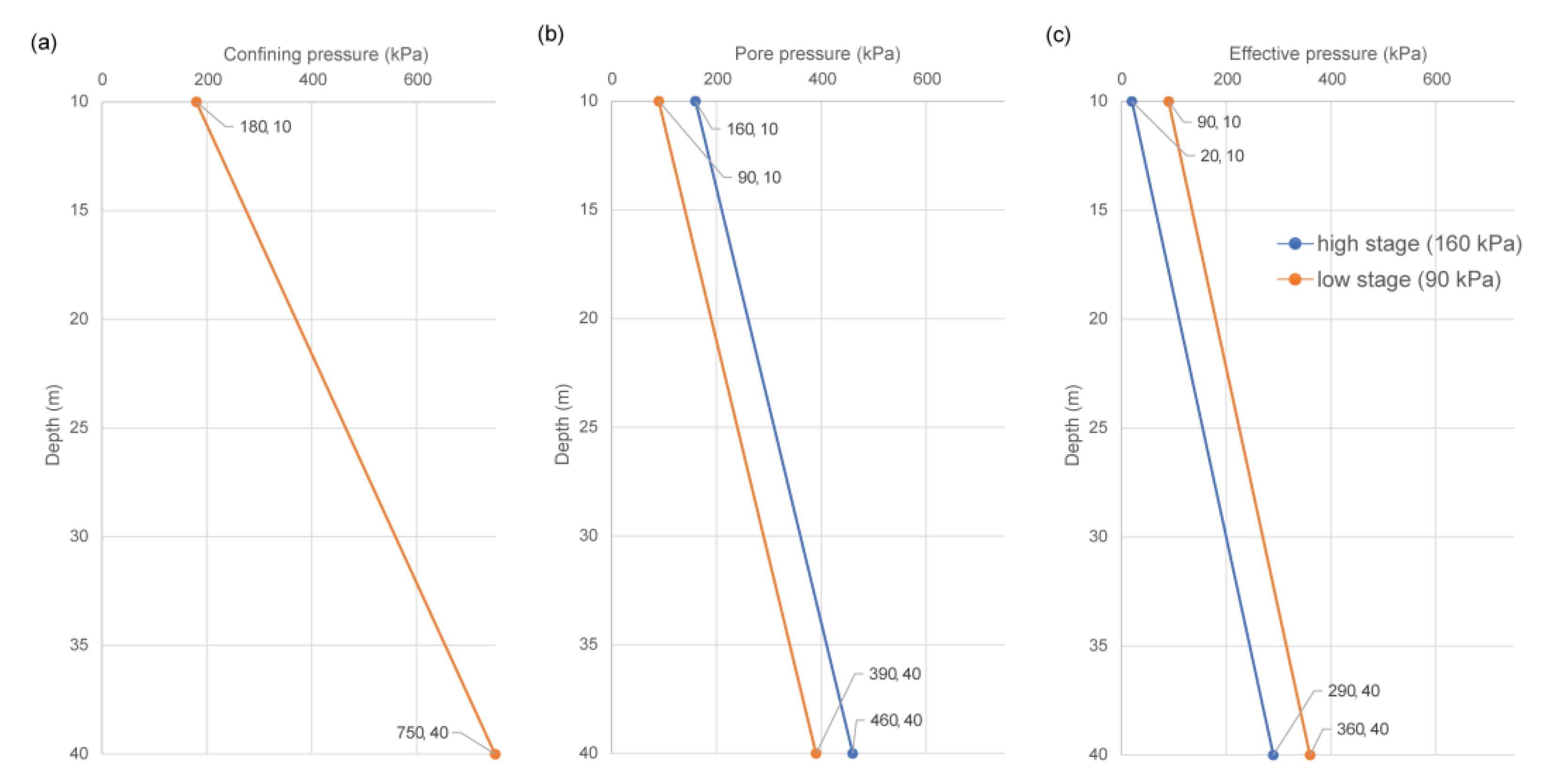
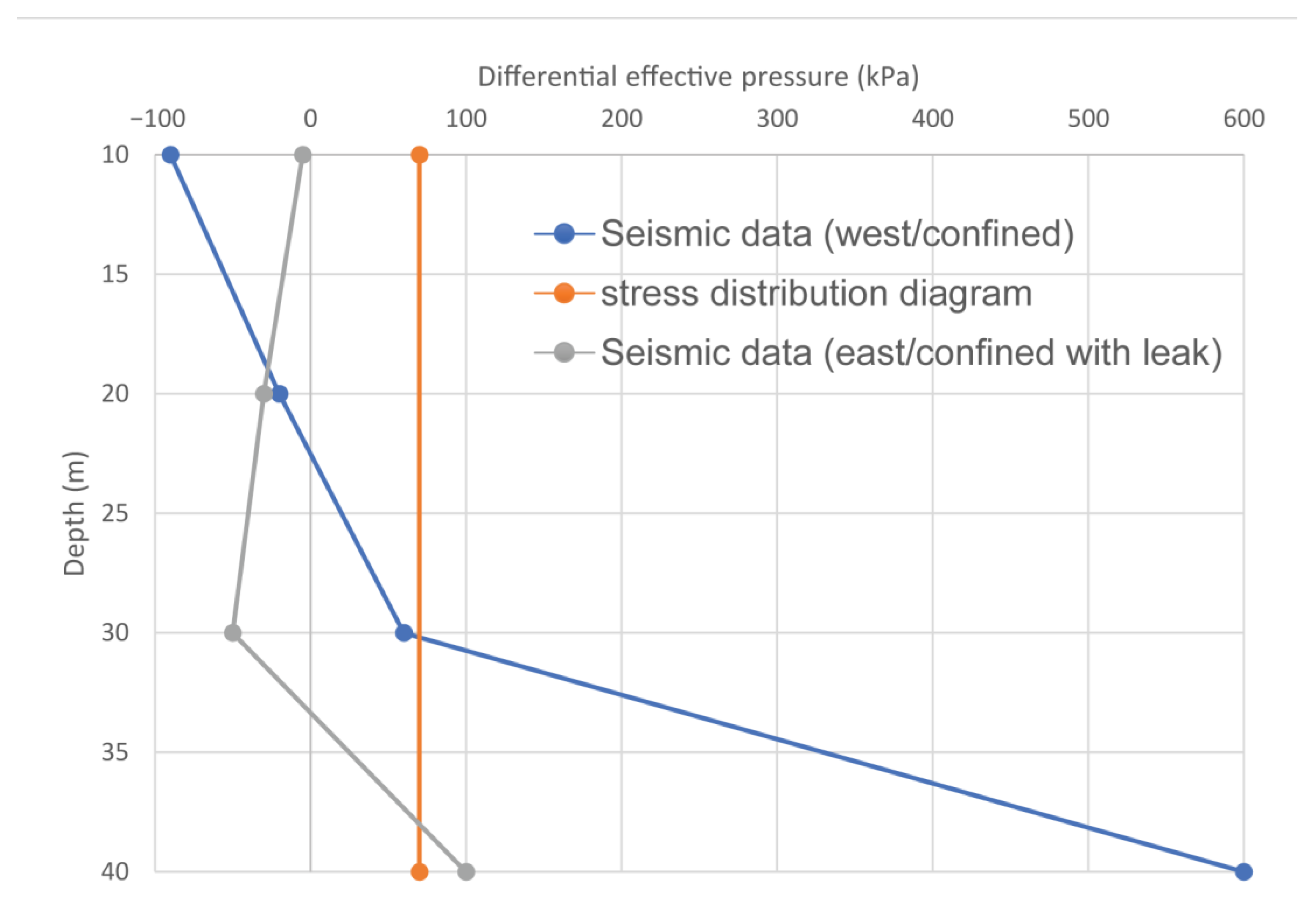
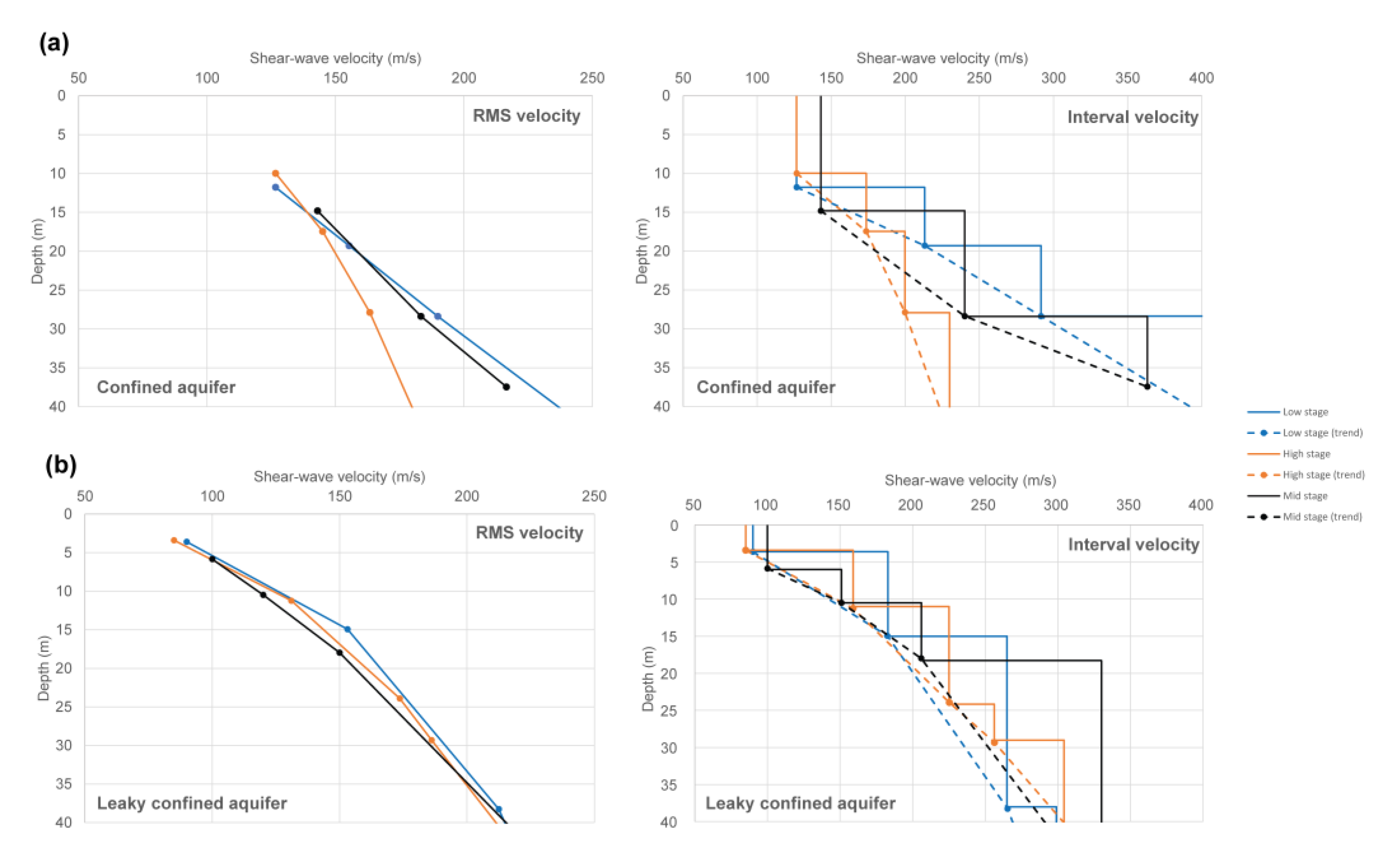
| Seismic Data Acquisition | Description |
|---|---|
| Geophone separation | 1 m |
| Source–receiver offset | 1–72 m for PWA, 1–48 m for CMP |
| PWA survey details | PWA survey used a fixed array of 24 geophones (1- spacing) with equally spaced seismic sources every 24 m [68,69,70]. |
| Geophones | 4.5 Hz horizontal component |
| Seismograph | 24-Channel, 24-bit resolution, DAQlink4 Seismic Source. |
| Seismograph take out cables | Two twenty-four (24) take-out cables linked in series for a total of forty-eight (48) channels controlled by Rota-Long-Switch. |
| Sample rate, record length, Nyquist frequency | 1000 S/s, 2 s, 500 Hz |
| Seismic source | Horizontal blows: I beam ~13.6 kg (30-lb), each head of the “I” is ~15.25 cm (6″) wide by ~28 cm (11″) long using ~4.5 kg (10-lb) sledgehammer. |
| Seismic data processing flow | |
| Data reformat | From SEG-Y to Seismic Unix format [71] |
| SH-wave enhancement | Polarity subtraction from opposite blow directions. |
| Geometry | Offset and CMP creation based on field notes and loaded to headers. |
| Automatic Gain Control (AGC) | 50 ms window |
| Band-pass filtering | Zero-phase, sine-squared tapered filter with corner frequencies at 30, 35, 60, 90 (Hz). |
| Top mute | Surface wave removal on each shot gather |
| f-k filter | To remove surface waves that were missed on top mute or overlaid reflection events with reject slopes. Slope values: 0,6,7,13,14,20 and −20, −14, −13, −7, −6,0. |
| Top mute (secondary) | Surface wave removal on each shot gather |
| Spiking Deconvolution | Spiking deconvolution is used to increase the signal density of the wavelet. |
| Normal moveout and stacking | The velocity analysis result is used to correct for normal moveout of seismic reflectors and stack the data to produce a post-stack image [72]. |
| Migration | Stolt post-stack migration [73] to correct dipping events to true subsurface position and collapse diffractions. |
| Survey | River Stage (ft) | River Stage (m) | Date |
|---|---|---|---|
| Seismic east (C-C’) | 44 (high) | 13.5 (high) | 9 March 2019 |
| Seismic east (C-C’) | 18 (low) | 5 (low) | 6 October 2019 |
| Seismic west (A-A’) | 44 (high) | 13.5 (high) | 14 May 2019 |
| Seismic west (A-A’) | 20 (low) | 6 (low) | 13 October 2019 |
| PWA Seismic east (D-D’) | 33 (intermediate) | 10 (intermediate) | 22 March 2021 |
| PWA Seismic west (B-B’) | 27 (intermediate) | 8 (intermediate) | 27 July 2021 |
Disclaimer/Publisher’s Note: The statements, opinions and data contained in all publications are solely those of the individual author(s) and contributor(s) and not of MDPI and/or the editor(s). MDPI and/or the editor(s) disclaim responsibility for any injury to people or property resulting from any ideas, methods, instructions or products referred to in the content. |
© 2023 by the authors. Licensee MDPI, Basel, Switzerland. This article is an open access article distributed under the terms and conditions of the Creative Commons Attribution (CC BY) license (https://creativecommons.org/licenses/by/4.0/).
Share and Cite
Locci-Lopez, D.; Lorenzo, J.M. Seepage-Induced Pore Pressure Variations Beneath an Earthen Levee Measured with a Novel Seismic Tool. Geosciences 2023, 13, 20. https://doi.org/10.3390/geosciences13010020
Locci-Lopez D, Lorenzo JM. Seepage-Induced Pore Pressure Variations Beneath an Earthen Levee Measured with a Novel Seismic Tool. Geosciences. 2023; 13(1):20. https://doi.org/10.3390/geosciences13010020
Chicago/Turabian StyleLocci-Lopez, Daniel, and Juan M. Lorenzo. 2023. "Seepage-Induced Pore Pressure Variations Beneath an Earthen Levee Measured with a Novel Seismic Tool" Geosciences 13, no. 1: 20. https://doi.org/10.3390/geosciences13010020
APA StyleLocci-Lopez, D., & Lorenzo, J. M. (2023). Seepage-Induced Pore Pressure Variations Beneath an Earthen Levee Measured with a Novel Seismic Tool. Geosciences, 13(1), 20. https://doi.org/10.3390/geosciences13010020






